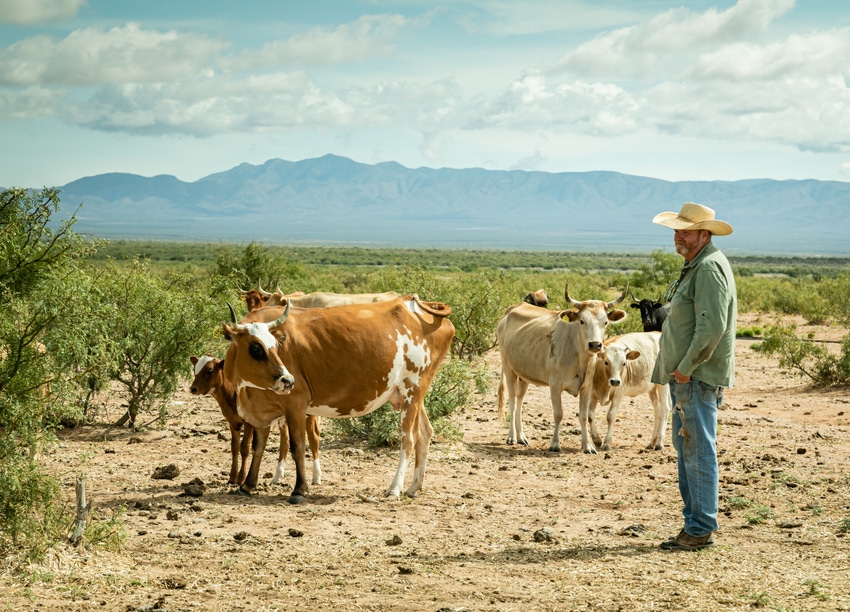Southwest beef research focuses on sustainable strategies
Five-year study to evaluate three strategies: heritage cattle genetics, precision ranching and novel options for marketing Southwest beef.
November 26, 2019

Environmental conditions are driving up the cost of raising cattle in the Southwest, but researchers at New Mexico State University (NMSU) have received a grant to help find new ways to make cattle ranching more sustainable.
NMSU’s College of Agricultural, Consumer & Environmental Sciences received an $8.9 million grant from the National Institute of Food & Agriculture to study ways to improve the sustainability of beef production in the Southwest.
Andrés Cibils, project director and professor of rangeland science in the department of animal and range sciences, explained that the grant will allow their team of ranchers, researchers, educators and Cooperative Extension Service specialists to evaluate three strategies: heritage cattle genetics, precision ranching and novel options for marketing Southwest beef.
The group will compare heritage versus conventional desert-adapted cattle in terms of profitability, productivity, ecosystem effects, feedyard performance and carcass and meat quality, NMSU said.
Increasing challenges for cattle producers in the Southwest include the climate getting drier and hotter as well as a shift in vegetation from grass to shrubs on much of the grazing land, the university said.
“Raramuri Criollo cattle have evolved in rugged and harsh environments of Mexico, and we’ve had the opportunity to evaluate them here in the Northern Chihuahuan desert,” said Sheri Spiegal, range management specialist at the U.S. Department of Agriculture's Jornada Experimental Range. “We’re seeing some promising patterns in their landscape use and behavior that could be valuable in some of the more challenging grazing environments with more shrubs and high temperatures.”
The second strategy is precision ranching, which uses sensors and technology to more accurately understand what is occurring on ranching landscapes without actually physically riding across the range. Imagine using sensors to check water levels, track cattle movements and monitor rainfall — all in real time.
“It’s an advantage for ranchers to know where cattle are at any given moment in real time and how they are behaving,” Spiegal said. “It is also beneficial for ranchers to be able to determine water levels in drinkers remotely, since they may have to drive far distances to check water levels or see if it rained in far-off pastures. We are evaluating precision ranching as a way to reduce some of those input costs spent on driving time and gasoline. Overall, it may provide a new and valuable way to understand what’s going on in your ranch.”
Cibils noted that profit margins for ranchers are already slim, so any strategies to help increase efficiency will help their business. “It’s really important, because traveling to check water twice a month instead of every other day is a big cost and time saver,” he said.
The third strategy deals with alternative supply chain options. Ranches in the Southwest are typically cow/calf operations that produce calves every year for export to stocker operations and ultimately to feedlots to be finished on grains.
“There’s an interest by American consumers in different ways of finishing beef, and people are increasingly interested in grass-fed beef, which can have some desirable nutrient profiles. Some consumers also perceive it as being more environmentally friendly, so we will be looking into the environmental and economic trade-offs of grass finishing in the Southwest,” Spiegal said.
Finishing on grass takes longer than in the feedlot, and opinions vary as to the health benefits of the two systems, NMSU said.
The grant will support this area of research for the next five years and involve upwards of 50 people working together from 12 institutions, including five cattle ranches located in New Mexico, Utah, California and South Dakota.
The team will build on previous research on Criollo cattle and precision livestock grazing tools as well as results of related research.
“A project like this creates a large body of research, and there will be long-term components of this that will carry on with other sources of funding,” said Brandon Bestelmeyer, research leader for USDA's Agricultural Research Service at the Jornada Experimental Range. “We’re hoping this project will kick-start some longer-term studies that we might be able to carry on for decades.”
Replication of NMSU studies of Criollo cattle in other countries will complement the team’s data and help test the viability of the strategies proposed by researchers.
“We have collaborators at a site in Mexico that will be replicating some aspects of the research we are doing with Criollo cattle in the Southwest. We also have collaborators at a site in Argentina working with their local Criollo cattle, comparing it to their mainstream beef breeds, as well as a possible collaborator in Uruguay” Cibils said. “We hope to work with them to assess the environmental footprint of Criollo cattle in different environments.”
Extension and education will be essential components of the project. Specialists in each of these areas will engage ranchers and K-12 students in the research itself and in the evaluation of each of the three proposed strategies.
While the project is in its early stages, the researchers plan to use technology to make the data and related information easily accessible to ranchers and the general public.
“We’re hoping to get all the results and integrate them with one user tool that can help both ranchers and beef consumers get the information they need so a rancher can see the cost savings of precision ranching or whether Criollo cattle will do well on their land,” Spiegal said.
You May Also Like



